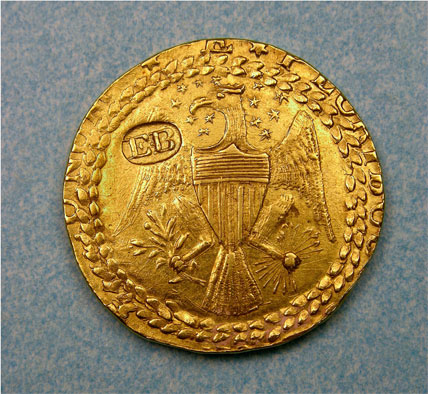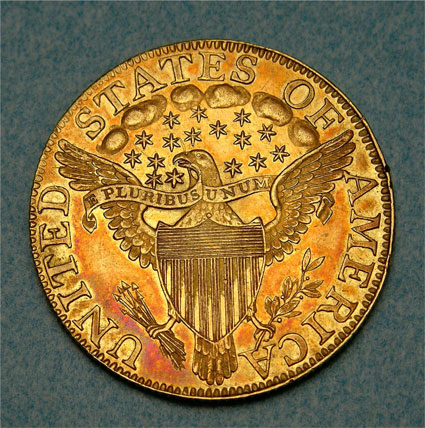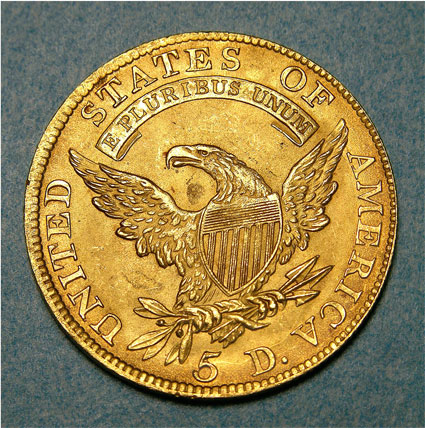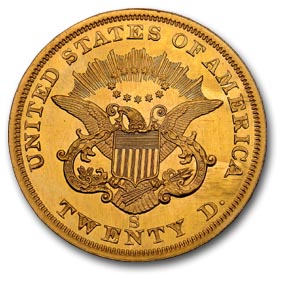The Arms of the USA—Artistic Expressions
by Joseph McMillan
One of the cardinal principles of heraldry is that each artist enjoys extensive freedom to depict a particular coat of arms in the style of his or her choice, provided only that the blazon, or official description of the arms, is followed. For the first century after they were adopted by Congress, the arms of the United States were officially emblazoned in a wide variety of styles, ranging from the staid and formal to the vigorous. By the late 19th century, however, the impression had arisen that only those emblazonments that conform to the one engraved on the actual great seal of the United States can be considered official. This led to an unfortunate stifling of the artistic creativity that had flourished in the rendering of the arms for a variety of official and unofficial purposes up until then.
The First Seal (1782)

Source: The Eagle and the Shield
Within months of its adoption, the first die of the great seal had been engraved and delivered to the Secretary of Congress, Charles Thomson, and put into use. This original die, which is believed to have been made by a Philadelphia engraver named Robert Scot, is now at the National Archives in Washington. It was first used on September 16, 1782, to authenticate a document by which Congress gave General Washington the authority to negotiate an agreement with the British concerning prisoners of war.
The seal seems to be the first depiction of the arms with the stars in the crest arranged to form a larger star. None of the sketches made in the design process show them this way. In addition, just as was the case in the sketches, but contrary to modern practice, the stars have six rather than five points. This was consistent with the manuals on English heraldry used by the designers, John Guillim's Display of Heraldry and Mark Anthony Porny's Elements of Heraldry, both of which insisted that stars (or estoiles, as they are known in heraldry) should have six points unless otherwise specified, and in any case must have no fewer than six. English usage refers to the five pointed object as a mullet, and considers it as representing the rowel of a spur. Such stars of six or more points were quite common on early American flags as well, and were even used on some U.S. coins on into the 20th century. Finally, the eagle is shown with a small feather crest on its head. This is the traditional heraldic way of emblazoning an eagle, even though the actual American bald eagle has no such crest.
St. Paul's Chapel, New York (1785)

St. Paul's Chapel, New York City
Hanging above what is known as the Presidential pew in St. Paul's Chapel, an Episcopal church in lower Manhattan, is a large oil painting of the national coat of arms, roughly four feet high by five and a half feet wide. The painting was commissioned by the vestry of Trinity Church, the parent parish of St. Paul's, pursuant to a resolution passed on October 7, 1785: "RESOLVED that the Committee of Repairs procure a painter to paint the Arms of the United States to be put up in St. Paul's Church." This is the earliest known full-color representation of the arms. Unfortunately, the name of the artist is lost to history. The emblazonment is notable for the random arrangement of the stars in the crest, the extension of the rays beyond the ring of clouds on all sides, and the placement around the shield of a gold chain and badge of some sort, evidently in emulation of the European practice of encircling the shield of a sovereign with the insignia of an order of chivalry.
A similar painting of the arms of the State of New York hangs above the Governor's pew opposite.
Trenchard's Engraving (1786)

Columbian Magazine,
September 1786
Source: Library of Congress
The Columbian Magazine of Philadelphia was an ambitious attempt in the wake of independence to create an American answer to the influential gentlemen's literary magazines of London. The magazine's first issue, which came out in September 1786, had as its frontispiece a finely executed engraving labelled "Arms of the United States" and signed by James Trenchard. Like the St. Paul's painting, the stars of the crest are scattered at random. The clouds form an arc above the eagle's head rather than the full ring that appears on both the 1782 seal die and the St. Paul's painting, and the rays of the glory break through the clouds, extending outward and upward to the edge of the frame. The project undoubtedly enjoyed the cooperation of William Barton, one of the arms' designers, as the magazine also printed the official blazon, the "Remarks and Explanation" submitted to Congress with the design in 1782, and two footnotes justifying and amplifying Barton's intentions in the design. Although not itself an official rendering, the Trenchard engraving had an evident influence on subsequent official emblazonments.
Indian Peace Medals (1789-95)

Source: Smithsonian Institution
As explained in Patterson and Dougall's The Eagle and the Shield, the various contending European powers had long tried to curry favor with the chiefs of North American Indian tribes by presenting "peace medals," usually engraved with the royal arms of the country concerned. The newly independent United States followed the same practice. By a resolution of Congress of April 28, 1786, the Treasury was authorized to have medals "with the Arms of the United States made of silver" for presentation to chiefs who had given similar gifts to U.S. officials. The practice continued under the new Constitution. During the Washington Administration, the medals were oval, usually made of silver, and continued to have the arms of the United States on one side. (The design on the other side varied from year to year; originally it showed an Indian chief with a peace pipe and the female personification of America.) Most of the later medals during this period are notable for the treatment of the crest, which follows the pattern of the Trenchard engraving, the clouds forming an arc above the eagle's head with the rays of the glory penetrating up and outward in a fan shape, a design very much like that of the modern Presidential version of the arms.
Military Colors and Drums (1780s-1920)
The use of the U.S. coat of arms on American military colors and standards may date to shortly after Congress relented on its disestablishment of the standing army by authorizing the raising of a new regular regiment in 1784. There are procurement records of the purchase of regimental standards at this time, but none of the flags are known to have survived, and no written description has ever been found. (Note: A number of Revolutionary era colors and standards have survived, but all of these predate the adoption of the arms of the United States in 1782.)

Source: Reproduction, National Defense University
Library Special Collections
It was definitely the central element of the ceremonial and combat flags that came into service shortly thereafter. In 1791, Secretary of War Henry Knox ordered four silk “standards” for the two new regiments of regular troops and two of levies that had just been authorized by Congress. The “standard” was one of two parade and battle flags carried by each regiment of infantry. The other, called a “color” was a simple flag with the number of the regiment on it; it was the standard that was considered the flag of national identity for a military unit. One of these 1791 flags, which was issued in 1795 to the 1st American Regiment (now known as the 3d U.S. Infantry, “The Old Guard”) is now preserved in the museum at West Point. It is made of dark blue silk with a striking rendering of the arms painted on the center. In an arrangement later seen on early White House china patterns, the eagle is depicted as if soaring up through the clouds against a brilliant multi-hued golden sunburst. The eight-pointed stars of the crest appear outlined in gold in a random pattern above the edge of the glory.
From that time until the early 20th century, each U.S. Army infantry regiment carried a dark blue flag with the arms of the United States emblazoned on it. The basic design, although in use from at least the 1790s, was first officially described in writing in an 1808 directive from the Secretary of War to the Purveyor of Public Supplies, and finally enshrined in the General Regulations for the Army in 1834. That directive now defined the blue flag with the arms as the “national color” for infantry, with what had previously been known as the “color” becoming the “regimental color.” At the same time, another flag of blue silk with the arms on the center, but much smaller, was adopted as the “standard” to be carried by the newly raised regiments of dragoons.

3d Infantry Regiment, ca. 1841
Source: U.S. Army

U.S. Treasury Guards
Displayed on Presidential Box,
Ford's Theater, April 14, 1865
Source: National Park Service
An important change took place in 1841, when infantry units received the Stars and Stripes as their national color. But the now-traditional dark blue flag with the national arms was not eliminated, but rather became the new regimental color. From that time until 1920, while artistic patterns of the arms changed from time to time, regiments of infantry in the U.S. Army continued to carry regimental colors that were dark blue with the arms of the United States on the center. Cavalry regiments carried blue standards with the arms until 1887, when they were authorized the Stars and Stripes as the national standard and yellow flags with the arms as regimental standards. While this is not the place for a detailed discussion of unit flags, it is worth noting that the use of the national arms for these flags eventually spread beyond the infantry and cavalry; by World War I the arms appeared on the organizational colors and standards of artillery, engineer, and signal units as well. It was only in 1920 that a substantial change was made, other than in the emblazonment of the arms. In that year, while the American bald eagle displayed remained on the regimental colors, the national shield and crest were replaced by the respective shields and crests of the individual units, a pattern that remains in use today.
In addition, the arms were also displayed on certain other regimental furnishings, such as trumpet banners and drums. Mid-19th century regulations required "the arms of the United States" to be painted on the front of regimental drums, for example, on blue for regiments of infantry and red for those of artillery. Such drums were carried into battle throughout the Civil War.

Source: Smithsonian Institution
The Diplomatic Medal (1792)
On April 29, 1790, President Washington recorded in his diary a decision to order the design of a medal to be presented “to Diplomatic characters when they return from that employment in this Country.” It had long been a custom at European courts for departing diplomats to receive lavish gifts from their hosts. Even a minister plenipotentiary—the second rank in the diplomatic hierarchy, but the highest then sent or received by the United States—might receive a "token" with a precious metal content, exclusive of workmanship, worth up to $2,500 ($90,000 at today's gold prices). After studying the practices of various foreign states, Washington and Jefferson settled on a less extravagant gift for envoys ending their assignments in America: a gold medal and chain, with a target value in the neighborhood of $500 to $600, just slightly less valuable than the medals and chains presented by the Dutch Republic.
The following day, Jefferson instructed William Short, the United States chargé d’affaires in Paris, to contract with a leading French medalist for the design and production of the medals, the first of which was to go to the former French minister in New York, the Marquis de la Luzerne. “The medal must be of 30 lines diameter, with a loop on the edge to receive the chain,” Jefferson wrote. “On one side must be the Arms of the United States, of which I send you a written description and several impressions in wax to render that more intelligible.” While Jefferson offered several ideas for the reverse, he left the final decision up to Short and his chosen artist.

by Augustin Dupré, 1792
Source: The Eagle and the Shield
Short contracted with the sculptor and engraver Augustin Dupré to design and strike the medals, which were completed in 1792. Dupré’s rendering of the arms (known only thanks to the discovery of his lead working model in the 1870s) is interesting in the positioning of the wings, which are more horizontal—expanded in heraldic language—than in the emblazonment on the great seal. Also, unlike the previous known emblazonments, Dupré arranged the clouds in the crest in an inverted arc, with the rays of the glory shooting through them and down behind the eagle.
The diplomatic medal had a short life, being presented only twice—to La Luzerne and his successor—before the practice of awarding it was terminated.
Coins (1792-1907)
The Act of Congress establishing the United States Mint in 1792 provided that all coins produced by the mint would have "an impression emblematic of liberty" on one side and, for the gold and silver coins, "the figure or representation of an eagle" on the other. Although the law did not specify that the eagle be in the form of the national arms, the gold coinage did show the arms from the very beginning. This may not be surprising in view of the fact that the first gold coins were designed by Robert Scot, the Philadelphia engraver who is believed to have been responsible for the 1782 die of the great seal. But even before the federal mint was created, New York had issued a gold coin, known as the Brasher doubloon, with a rough rendering of the national arms on one side and those of New York on the other. The arms continued to appear on the reverse of most U.S. gold coins until 1907-08. Below are a selection of renderings of the arms of the United States as they have appeared on American coins over the years.
White House China (ca. 1817-1825)

Source: National Archives
The first several Presidents of the United States and their wives used formal dinner services with their own personal devices on them--an interlaced W and M for Martha Washington, the initials TJ for Thomas Jefferson--for official entertaining in the capital. From the Madison Administration onward, however, many have chosen to use china patterns decorated with a version of the national arms. Lately the emblazonment selected has almost invariably been the standardized pattern known since 1946 as the "Presidential arms," but in earlier years there was significant artistic leeway. The illustration shows a plate from the Administration of James Monroe (1817-1825). The china used by several other Presidents, including Andrew Jackson, Abraham Lincoln, and Benjamin Harrison, had similar emblazonments of the arms, but with different patterns for the border.
The Masi Treaty Seal (1825)

Source: The Eagle and the Shield
Since our purpose here is to discuss the arms of the United States and not the great seal as such, there is no reason to address every one of the emblazonments appearing on the different dies of the seal. Nevertheless, this version deserves special note for two reasons: (1) for the vigorous sense of motion imparted by the artist, Seraphim Masi; and (2) because it emphasizes the point that, even in the context of the seal, very different styles of representation are permissible. Apart from the obvious difference in the posture of the eagle, note that Masi chose a different shape for the shield, placed the scroll above the eagle's head instead of across its neck, and has the clouds in the crest open at the bottom so that the rays of glory can break through down and behind the eagle.
The Masi die was created to provide a large and impressive version of the seal--over 4 1/2 inches in diameter--suitable for affixing as a pendant seal to U.S. instruments of ratification of treaties with foreign powers. The same basic emblazonment was also used for the "skippets," or round metal boxes, within which the pendant wax seal was encased for protection after being applied to the instrument of ratification.
Salem Custom House, Salem, Mass. (1826)

Salem, Mass., Custom House
Source: National Park Service
Carvings of the arms of the United States, usually produced by local craftsmen, were a common fixture on federal buildings of the late 18th and early 19th centuries, particularly custom houses in the major seaports, such as Salem, Massachusetts. The illustration shows a fiberglass casting of a particularly fine example by the Salem woodcarver Joseph True. The original, much decayed after almost 180 years of exposure to the maritime climate, was replaced in 2004 and will be displayed inside the custom house following restoration. Note the stars on the chief of the shield--a style of emblazonment commonly, but mistakenly, used when the crest of the arms was omitted.
The Tiffany Seal Emblazonment (1885)

of the Tiffany emblazonment
Source: The Eagle and the Shield
In 1881, with the centennial of Independence having just passed and that of the adoption of the great seal just around the corner, a wave of public interest in the seal and arms, combined with the worn condition of the existing dies, led the Department of State to make inquiries about contracting for a new engraving of the great seal. In 1883, the New York firm of jewelers, Tiffany & Company, was selected for the job, and turned to its chief designer, James Horton Whitehouse, to prepare the drawings. Meanwhile, however, the department official in charge of the seal had contacted a number of luminaries in a variety of fields for advice on the design. These included the country's leading botanist (for advice on the olive branch), an eminent professor of art history at Harvard, the same college's librarian, the sculptor Augustus Saint-Gaudens, the well-known author Edward Everett Hale, and the two most prominent American heraldists of the day, William H. Whitmore and William S. Appleton of the New England Historic Genealogical Society's Committee on Heraldry. The "experts" debated virtually every component of the design: Should the arrows be conventional barbed arrows or stone-headed arrows in the American Indian style? Should an American olive or European olive branch be used? Should the eagle be portrayed heraldically or naturalistically? Should the tips of the wings be pointed up or down? How many feathers should be in its tail?
With all this debate, it's a miracle that Whitehouse ever finished the job, let alone that he produced the beautifully executed emblazonment that has graced the great seal ever since. In fact, he may have done the job too well. Combined with a spirit of bureaucratic standardization that characterized the late 19th and early 20th centuries--it was the era in which numerous state legislatures fixed the design of state arms according to fixed models--the artistic quality of the Tiffany rendering soon drove almost all other emblazonments out of official use. Whitehouse's staid, dignified, but static eagle, drove the fierce birds off of the Army's regimental colors and the Navy's Presidential flag. When federal agencies whose seals featured the national arms had the dies re-cut, they almost invariably directed that the new dies match the rendering of the arms on the great seal. Indeed, ever since 1885, whenever the Department of State has needed to replace a worn-out seal, it has mandated that the replacement replicate the Tiffany design almost exactly. The only change, almost imperceptible, was the addition of tiny dots indicating the color gold among the rays of the glory in the crest, introduced in the die produced by Max Zeitler of Bailey, Banks and Biddle in 1904. Since then, the production of a new great seal has involved no artistic creativity, while the production of other items on which the arms are traditionally used, from uniform cap badges to passport covers, has been little more than a cookie cutter operation. In the process, a vibrant heritage of heraldic artistry has been sadly lost.




